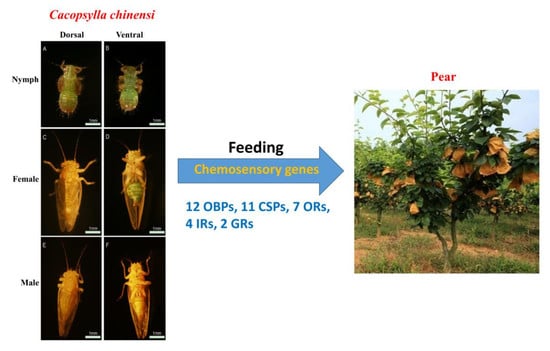Chemosensory Gene Families in the Oligophagous Pear Pest Cacopsylla chinensis (Hemiptera: Psyllidae)
Abstract
Share and Cite
Xu, J.-W.; Zhu, X.-Y.; Chao, Q.-J.; Zhang, Y.-J.; Yang, Y.-X.; Wang, R.-R.; Zhang, Y.; Xie, M.-Z.; Ge, Y.-T.; Wu, X.-L.; et al. Chemosensory Gene Families in the Oligophagous Pear Pest Cacopsylla chinensis (Hemiptera: Psyllidae). Insects 2019, 10, 175. https://doi.org/10.3390/insects10060175
Xu J-W, Zhu X-Y, Chao Q-J, Zhang Y-J, Yang Y-X, Wang R-R, Zhang Y, Xie M-Z, Ge Y-T, Wu X-L, et al. Chemosensory Gene Families in the Oligophagous Pear Pest Cacopsylla chinensis (Hemiptera: Psyllidae). Insects. 2019; 10(6):175. https://doi.org/10.3390/insects10060175
Chicago/Turabian StyleXu, Ji-Wei, Xiu-Yun Zhu, Qiu-Jie Chao, Yong-Jie Zhang, Yu-Xia Yang, Ran-Ran Wang, Yu Zhang, Meng-Zhen Xie, Ya-Ting Ge, Xin-Lai Wu, and et al. 2019. "Chemosensory Gene Families in the Oligophagous Pear Pest Cacopsylla chinensis (Hemiptera: Psyllidae)" Insects 10, no. 6: 175. https://doi.org/10.3390/insects10060175
APA StyleXu, J.-W., Zhu, X.-Y., Chao, Q.-J., Zhang, Y.-J., Yang, Y.-X., Wang, R.-R., Zhang, Y., Xie, M.-Z., Ge, Y.-T., Wu, X.-L., Zhang, F., Zhang, Y.-N., Ji, L., & Xu, L. (2019). Chemosensory Gene Families in the Oligophagous Pear Pest Cacopsylla chinensis (Hemiptera: Psyllidae). Insects, 10(6), 175. https://doi.org/10.3390/insects10060175




